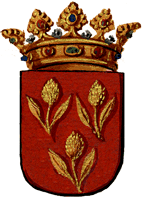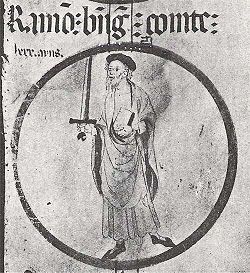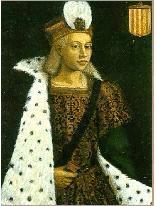Raimund Folch I. de Cardona
Raimund Folch I. de Cardona († 1086 ) ( Spanish : Ramón Folch de Cardona) was a Catalan nobleman who was vice count ( Catalan : vescomte) of Cardona (in Catalonia, in the north of Spain ) from 1040 to 1086 and one of his time the most influential vassals of the Counts of Barcelona . He played a not insignificant role both in the internal disputes and in the context of the " Reconquista ".
origin
Raimund Folch I comes from the oldest historically secured house of the Vice Counts of Cardona. Their extensive territory was around the city of Cardona in the center of the county of Barcelona (today's province of Barcelona in the autonomous community of Catalonia ). According to tradition, this house is derived in the female line from Argencia, an alleged daughter of Charlemagne (800-814), whose husband, Fulco of Anjou , is said to have been appointed Vice-Count of Girona by her father. One descendant, Raimund Folch III., Was appointed by Wilfried I "the hairy" Count of Barcelona († August 11, 897) as the first vice-count of Cardona, from whom the vice-count fell through an heir to the first historically tangible house of Cardona be.
Regardless of this non-verifiable ancestry, the Cardona house in question is one of the oldest noble families in the county of Barcelona, as the first historically verifiable ancestor, Vice Count Guadald von Osona , died before 973. According to documents from the "Fundación Casa ducal de Medinaceli", the beginning of the Osona family can be traced back to 879.
The eponymous Castell de Cardona was built by order of Wilfried I the Hairy (878–895). Although located in northern Spain, it was destroyed by the Saracens in 985 when troops of the Caliphate of Cordoba, under the command of the regent Muhammad ibn Abdallah ibn Abi Amir, better known as Almansor , captured Barcelona. Immediately after their departure, Borrell II , Count of Barcelona , Girona and Osona (947–992) began to rebuild the destroyed castles and to repopulate the deserted areas. In the relevant document of April 23, 986, among other things, the Castell de Cardona was transferred to the Vice Count Ermemir, the son of the Vice Count Guadald von Osona.
Raimund Folch I himself was the son of Vice Count Folch I de Cardona, who died around 1040, a descendant of Vice Count Guadald von Osona. Only the first name Guisla is known of his mother, but not her family name or origin.
Life
Raimund Folch I grew up in the Castell de Cardona together with his younger brother Folch II. De Cardona, who was Bishop of Urgell from 1092 to 1095 and Bishop of Barcelona from 1096 to 1099 . The father of Raimund Folch I - Vice Count Folch I de Cardona - was murdered by his enemies in 1040. Since Raimund Folch was still a minor, his uncle - the younger brother of his father - Eribald de Cardona, Bishop of Vic, took over the rule of the Vice- County of Cardona. However, Eribald died that same year on a pilgrimage in the Holy Land .
Raimund Folch I therefore took over control of the vice-county of Cardona from his uncle in 1040 - presumably under the tutelage of his mother.
Inheritance dispute in the county of Barcelona
As Vice Count Raimund Folch I was the official of the Counts of Barcelona and played an important role as one of the most powerful nobles in the politics of the county. This was because he was one of the few vice counts who not only had their official function as agent and deputy of the count, but also had their own, clearly defined territory, a vice county. At the same time, he was one of the richest vassals of the Counts of Barcelona due to the profitable salt mining in his territory.
When Raimund Folch I took over his vice-county, the county of Barcelona was in a difficult phase: Berenguer Ramón I called "el Corbat" (the hunchback), Count of Barcelona, Girona etc. etc., had the division of his in his will extensive territories to his three sons Ramón Berenguer I , Sancho and Guillermo. When he died in 1035, his sons were still minors, which is why the regency was taken over by their energetic grandmother Ermessenda von Carcassonne , who had already significantly influenced the government of the county.
This circumstance was used by the nobility to break away from the count's authority as much as possible and to act as independent masters of their territories. In the resulting power struggle between central power and the nobility and the rivalry between the brothers, Raimund Folch I de Cardona supported his direct fiefdom, Ramón Berenguer I , called el Vell (the old man) (* around 1023, † 1076 ), who the Inherited counties of Barcelona and Girona (1035-1076), and ruled them jointly with his grandmother.
Against this authoritarian government, there was an uprising of the nobility, which was led by the nobleman Mir Geribert von Penedés, who allied against the count's authority with Guislabert, the bishop of Barcelona (1035-1062). An important motive for the uprising was the rejection of the official policy of peaceful coexistence with neighboring Islamic states. Although this was good for the central administration because of the trade and tribute payments of these states, it hindered the politics of the nobility of conquering and looting neighboring Muslim areas.
Count Ramon Berenguer I. was next to Raymond Folch I in his fight especially his grandmother Ermessenda of Carcassonne (* 975-978; † 1057 in Sant Quirze de Besora), the heir to the County of Carcassonne and the County Razes in West Francia , of their brother Pere Roger of Carcassonne, Bishop of Girona (1010-1050), and supported by the famous Abbot Oliva (* 971, † 1046), who came from the house of the Counts of Cerdanya and Besalú , first Count of Berga , then a monk in the Benedictine order, from 1008 abbot of the Benedictine Abbey of Ripoll and from 1018 bishop of Vic and venerated as the spiritual father of Catalonia.
With the support of Raimund Folch I de Cardona, Count Ramon Berenguer I succeeded in acquiring the County of Osona from 1054 as heir to his eldest brother Guillermo and from 1067 also the County of Carcassonne and the County of Razès .
The government of the county of Barcelona, which was consolidated by Count Raimund Berengar I, slipped into another crisis after his death in 1076. In his will, the latter had provided for the joint rule of his twin sons Raimund Berengar II and Berengar Raimund II and placed both under the guardianship of Pope Gregory VII (1073-1085). As expected, there were inheritance disputes between the sons, with Raimund Folch I supporting the older son, Raimund Berengar II. Called "Cap d'Estopes" (flax head) (* 1053, † 1082). Through papal mediation, a compromise was reached that divided the lands and stipulated that both counts would alternately reside in the count's castle in Barcelona every 6 months.
Towards the end of his life, Raimund Folch I had to experience that his feudal lord, Count Raimund Berengar II of Barcelona, was killed while hunting on December 5, 1082 or - as many suspected - was murdered on the orders of his brother Berengar Raimund II, which this the surname "el Fratricida", the fratricide, registered. Raimund Folch I. de Cardona then formed an alliance with Bernat Guillem de Queralt to fight and prosecute those who were responsible for the count's murder.
In view of the suspicion that the count's brother, Berengar Raimund II of Barcelona could have had a hand in the murder, a dispute arose over the guardianship of the young heir to the county of Barcelona, Raimund Berengar III. (* 1082, † 1131). Raimund Folch I was one of the leading barons who insisted that the guardianship of the young count was not transferred to his uncle, Berengar Raimund II, but to the count of Cerdanya Wilhelm Raimund (1068-1095). The young Count of Barcelona would later not only be called “the great”, but also marry Maria Rodriguez de Vivar († approx. 1105), a daughter of the Spanish national hero Cid , whom his father had years before - together with Raimund Folch I . de Cardona - had fought.
Despite the loss of his direct lord, Ramon Folch I de Cardona later took part in Count Berengar Raimund II's campaigns against the neighboring Islamic states.
Fight against the Saracens
Ramon Folch I excelled in the military field in the campaigns in which the Counts of Barcelona took part. There was enough opportunity to do so, as the county of Barcelona bordered in the south on Muslim small kingdoms, the so-called “ Taifa kingdoms ”, which after the deposition of Hisham III. , the last caliph from the Umayyad dynasty and the collapse of the Cordoba caliphate after 1031 under local dynasties. The external relations of the County of Barcelona were therefore often marked by fighting against its Muslim neighbors.
This initially uncoordinated struggle to recapture Christian territories from Muslim rule, the so-called " Reconquista ", was made a matter of concern for all of Christianity by Pope Alexander II (1061-1073) by launching a holy war against the unbelievers in 1063 and granted the conquerors of the city of Barbastro a full remission of sins. A new view that Pope Gregory VII followed in 1073/74 on the occasion of the Ebolus campaign of Roucy.
Despite these wars between Christians and Muslims, there was not only an exchange with the then culturally much more developed Muslim world, but also cross-border military cooperation. In the face of aggressive neighbors of one's own religion, cooperation with neighboring states of the other religion appeared to be the lesser evil in many cases.
Raimund Folch I. had the opportunity to experience this practice for himself on the basis of a prominent case. Rodrigo Diaz de Vivar (* around 1043 in Vivar, † July 10, 1099 in Valencia) - who later went by the name "el Cid" (from the Arabic as-sayyid /السيّد / 'The Lord' the Lord) as a Christian hero who was to become immortal in the “Reconquista” - long served his feudal lords, the kings of León and Castile. However, he fell out with the new sovereign Alfonso VI around 1080/81 . , King of León (1065–1109) and King of Castile (1072–1109), called "el Emperador" (the emperor) and therefore retired from his service. In search of a new client, he and his team came to Barcelona, where he offered his military services to the jointly ruling Counts of Barcelona, Raimund Berengar II. And Berengar Raimund II.
Since this offer was rejected and no other Christian ruler wanted to use his services, the Cid and his followers entered the service of the Muslim kings of Saragossa from the house of Banu Hud , who were dependent on the Kingdom of León .
The Cid initially served under Al-Muqtadir (Abu Ja'far Ahmad al-Muqtadir bi-Llah ibn Sulayman), King of Saragossa (1046-1081) - the builder of the magnificent residence of the Muslim kings of Saragossa, the Aljaferia- Palace. After his death in 1081 he was in the service of his son Yusuf al-Mu'tamin (1081-1085).
In the neighboring Muslim kingdom of Lérida (today Lleida province in the autonomous community of Catalonia), a brother of King Yusuf al-Mu'tamin of Saragossa, namely Al-Mundir (Al-Mundir al-Hayib 'Imad ad Dawla), ruled at the same time. Since this was threatened by his powerful brother Yusuf al-Mu'tamin, he turned to the neighboring Christian states for help and concluded military alliances with them. First with the Kingdom of Navarre , then with the Counts of Barcelona and finally with the Kingdom of Aragón .
In 1082 there was the memorable battle near Almenar, where two Muslim states - each with the support of Christian troops - fought each other. On one side stood Al-Mundir, the Muslim king of Lleida (Lérida), who was supported by the Christian troops of Count Berengar Raimund II of Barcelona and Count Wilhelm Raimund (Guillermo Ramón) I of Cerdanya (1065-1095) has been. On the other side was the army of the Kingdom of Zaragoza, which was made up of Muslim and Christian contingents and was under the command of the - Christian - Cid.
The latter proved to be the better general and defeated the army of King Al-Mundir of Lleida and his troops from Barcelona. The Count of Barcelona and his entourage - which also included Raimund Folch I with his posse - were captured and had to buy themselves out with high ransom payments.
Raimund Folch I also took part in the military campaigns of the Counts of Barcelona against the neighboring Islamic states and finally fell in the battle against the Saracens in 1086 near Maldá Castle. It was critical that at the same time his only son and heir, Bremond II. De Cardona, fell into captivity by the Muslims. As a result, Folch II. De Cardona, the younger brother of Raimund Folch I, had to take over the reign of the vice-county for his captured nephew Bremond II, although he was bishop of Urgel and Barcelona. This reign turned into a rule, as Bremond II died soon after in captivity. However, this paved the way for a change in the dynasty, since Folch II as bishop had no children and Raimund Folch I only had one daughter named Ermessenda, who was married to the Catalan nobleman Deodat Amat de Claramunt.
In the absence of a male heir, their son, Bernat Amat de Claramunt, was appointed as heir by his uncle Folch II. De Cardona, Bishop of Barcelona - the last Vice Count of Cardona of his house. When Folch II died shortly before 1100, Bernat Amat followed as the first Vice Count of Cardona from the House of Claramunt.
Marriage and offspring
Raimund Folch I. de Cardona, the penultimate Vice Count of Cardona of his house, was married to a woman named Ermesinda, whose origin is unknown.
Children:
- Bremond II. De Cardona, Vice Count of Cardona († 1086 or shortly afterwards in Saracen captivity)
- Ermessenda de Cardona ∞ Deodat Amat de Claramunt
Their son Bernat Amat de Claramunt followed before 1100 as the first Vice Count of Cardona from the House of Claramunt and became the progenitor of the second house of the Vice Counts of Cardona.
Individual evidence
- ↑ This is not discussed in detail in the Wikipedia article House Folch de Cardona .
- ↑ a b S. Sobrequés i Vidal: Els barons de Catalunya. In: Biografies Catalanes. III. Editorial Vicens-Vives, Barcelona 1961, p. 51.
- ↑ a b c S. Sobrequés i Vidal: Els barons de Catalunya. In: Biografies Catalanes. III. Editorial Vicens-Vives, Barcelona 1961, p. 52.
- ↑ Ermemiro I de Osona [Cardona]. on: fundacionmedinaceli.org
- ↑ a b S. Sobrequés i Vidal: Els barons de Catalunya. In: Biografies Catalanes. III. Editorial Vicens-Vives, Barcelona 1961, p. 53.
- ↑ Portner: Operation Holy Sepulcher. Legend and Reality of the Crusades (1095-1187). Econ Verlag, Düsseldorf 1977, p. 47, p. 49.
- ^ Francisco García Fitz: Relaciones políticas y guerra. La experiencia castellano-leonesa frente al Islam. Siglos XI - XIII. Universidad de Sevilla, 2002, ISBN 84-472-0708-0 .
- ↑ MJ Quintana: Vidas de espanoles célebres. Colección Austral, no 826, Espasa-Calpe, Madrid 1959.
- ^ Alberto Montaner: Cantar de mio Cid. Crítica, Barcelona 2004, ISBN 84-8432-121-5 , p. 264. (Biblioteca Clásica, 1)
literature
- S. Sobrequés Vidal: Es barons de catalunya. Editorial Vicens-Vives, Barcelona 1961.
- MJ Quintana: Vidas de Espanoles célebres. El Cid - Guzmán el Bueno - Roger de Lauria. Colleccion Austral 826, Editorial: Espasa-Calpe SA 1959.
- Géronimo Pujades: Crónica Universal de Cataluña. 1829.
See also
Web links
- Ermemiro I de Osona [Cardona.] At: fundacionmedinaceli.org
| personal data | |
|---|---|
| SURNAME | Raimund Folch I. de Cardona |
| ALTERNATIVE NAMES | Ramon Folch de Cardona |
| BRIEF DESCRIPTION | Vice Count of Cardona |
| DATE OF BIRTH | 11th century |
| DATE OF DEATH | 1086 |
| Place of death | Maldá |





